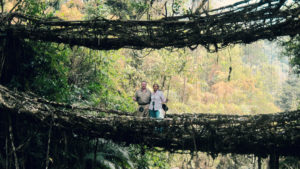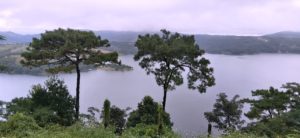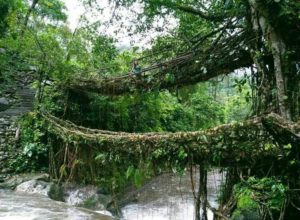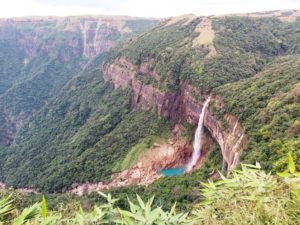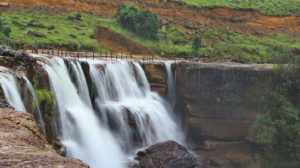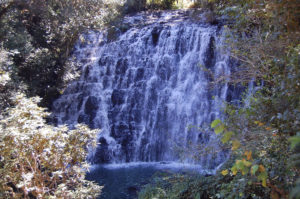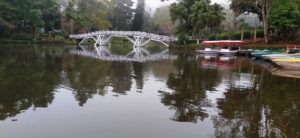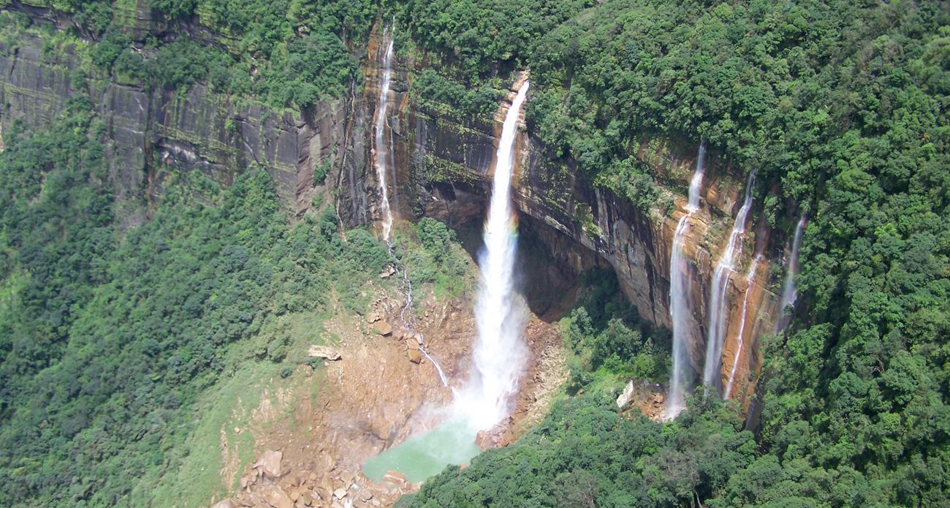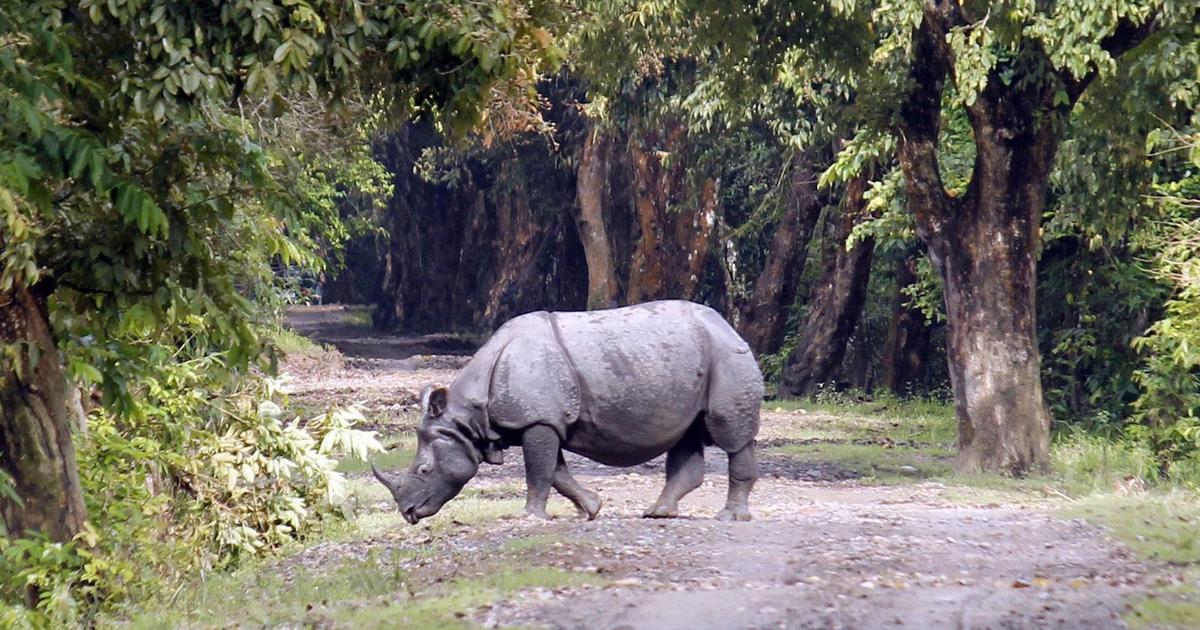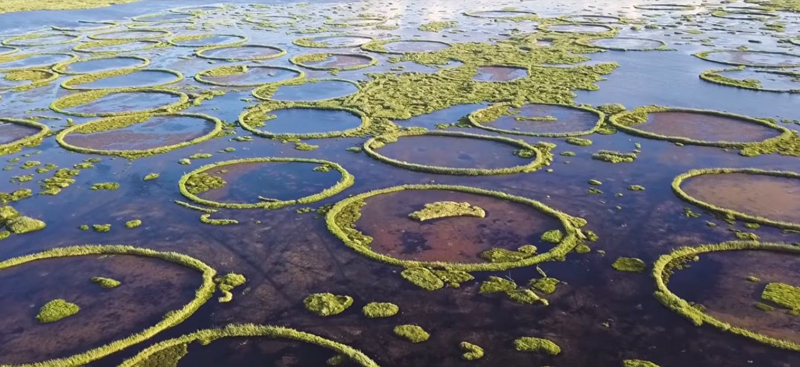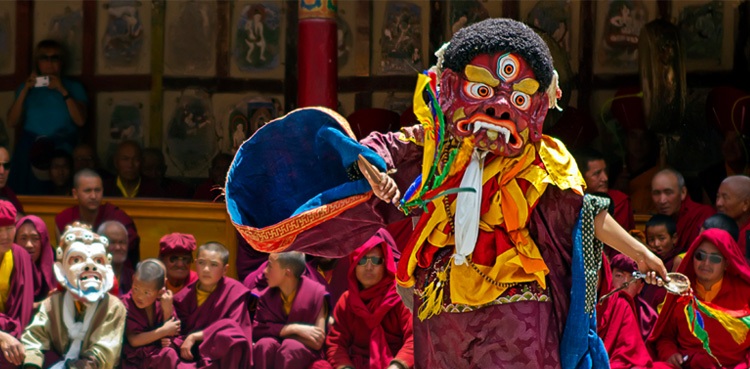Tour Highlight
The trek to the Double Decker Living Root Bridge in Cherrapunjee will surely be one of the most fascinating and exhilarating hikes of any adventure seekers life.
- The Double Decker Living Root Bridge
Enjoy the clear blue water, natural root bridges, winding steps, natural swimming pools and of course the incredible natural view clubbed with the most amazing weather.
- Waterfalls in Cherrapunjee
The pristine lakes and the cascading waterfalls in shillong and cherrapunjee will surely be enough for you to hold your breath and admire the beauty of the nature.
Itineraries
Day 01: Arrive Guwahati/ Cherrapunjee (160 Kms, 6 hrs drive)
Arrive Guwahati by flight/ train.
Meeting upon arrival and depart for Cherrapunjee
En route visit
- Umiam Lake Shillong
Barapani (Umiam Lake): As per the legends, two heavenly sisters decided to make their way to Meghalaya. However, one of them had reached the destination and the other could not due to some reason. So the former could not traced out her sister and started crying with her broken heart. She cried so much that and a lake was formed with her tears. Locally known as Umiam Lake, Barapani means vast waters.
Today it becomes a hub for the water sports activities such as speed boats, sailboats and water scooters. Adjoining to the lake, the Nehru Park offers an aviary and a collection of orchids and butterflies.
Arrive Cherrapunjee and check in at Cherrapunjee Holiday Resort.
Cherrapunjee: is a small hamlet, situated at an altitude of about 4823 feet (1484 m). Locally known as ‘SOHRA’. Cherrapunjee is located in the southern most point of Khasi hill sharing the border of Sylhet district of Bangladesh. Cherrapunji offers a panoramic view of the hilly terrains, deep gorges and valleys with its spectacular waterfalls. It was once having the record of being the wettest place on earth, with an average rainfall of about 1150ms. However, this record has been overtaken by a nearby place Mawsynram
Evening free at leisure.
Overnight at resort.
Day 02: Cherrapunjee
Morning after breakfast full day trekking and nature walk to the living root bridges with a local guide
- Double Decker Living Root Bridge
The Living Root Bridges: These exclusive bridges are found only in Cherrapunjee. Some of these bio engineering wonders are 53 feet, 70 feet, 100 feet long. The Double Decker Root Brides have two levels and can carry many people at a time. These bridges are not reachable by road and one has to walk in order to reach these living wonders.
TREKKING OPTIONS:
Trek to the Living Root Bridge, Ummunoi.
Duration: 3-4 hours from the Resort. Distance 4 km down and up 1000 feet approximately. Trek open throughout the year.
This trek starts goes down hill through village Sohsarat. The steps are relatively steeper in two short stretches. Half the distance is covered by steps going down hill. Then there is a jungle path going along the sides of the hill leading to the Living Root Bridge with a few steps after short stretches of sloping foot path. Moss thrives on these sandstone steps during the monsoon and makes them slippery. However, the steps can be negotiated easily with little care by locking the hind of your feet in the depressions between stones in the steps. Our guide comes handy to steady you. The path thru’ the jungle and bay leaf gardens is quite interesting. As you near the bridge you hear the sound of water flowing by the stream. After admiring the Living Root Bridge and taking snaps, get down into the stream and take a refreshing bath in the stream. En-route you get to see snails, millipedes, butterflies and spiders in their webs.
After seeing the bridge you move ahead to a naturally formed Dolomite archway. Notice how the villagers tap the water from the stream by bamboo pipes running long distances to drip irrigate the betel leaf creepers during the dry season in winter.
Trek to Double Decker Root Bridge and Natural Swimming Pools
Duration: 9 hours involving 7 hours walking, down hill 2500 feet and up.
Total distance of approximately 25 km of which 10 km is by a beautiful mountain skirting road commanding a beautiful view of the valley and through three interesting Khasi villages and can be done by vehicle if anyone wants to save time and energy. Trek open throughout the year.
This is one of the most beautiful and very popular treks. The high points of this trek are the Double Decker Root Bridge and the natural swimming pools in the river bed. The people of the gorge village Nongriat where the Double Decker Root Bridge is located are very friendly and very special. The trek down stone steps is steep for almost half of the trek down. This trek is open through-out the year and are being used by the villagers of Nongriat, Nongthymmai and Mynteng daily, when it rains and when the sun shines. The steps become slippery during the monsoon months and have to be negotiated with little care to avoid slipping. The rivers in spate and streams and waterfalls in full flow during the monsoon months add magnificence to the root bridges spanning these rivers and streams. Contemplate the raw force of nature standing on the Steel Rope bridges strung taut across the river 45 feet above normal water level, when the river is in spate after very heavy rainfall. You need to be strong willed and brave.
Before reaching the Double Decker Root Bridge you come across the more Living Root Bridges and Steel Rope bridges. The valley scenery is very impressive. Beyond the Double Decker Root Bridge you walk on level ground another 2 km (say 20 minutes) to reach Mawsaw Steel Rope Bridge. From here you access our famous natural swimming pools. The larger pool is deep and we recommend only good swimmers to attempt it. The smaller pool can be used by others. However, when the river is in spate please don’t attempt swimming. When the flow is normal, you see the bottom of the pools very clearly, so clear is the water. The colour of the water is so inviting for a swim. After a refreshing swim, it is time for lunch. Please bring back the garbage for proper disposal.
Leave the pool side by 2:30 p.m. to reach the top before it is dark.
Trek to Mawsiekhriah / Khlieh Mawlong
Duration – 2 hours. Distance 6 km approximately. Open throughout the year.
This is a light trek on the top of the hill almost on level ground passing through the forests of Laitkynsew, passing by the vegetable gardens in winter, a vast natural rock garden and a steep rock cliff face dropping off a few hundreds of feet overlooking Mawlong village and the limestone mines of Ichhamati. Along the way you pass by a few mountain streams and can hear some flowing by underground channels. The Sylhet plains of Bangladesh spreads across to your south from the foot of the hills. You get a captivating view of the plains and can see Sylhet, Chhatack towns in Bangladesh from here. Now Border Area Development Authority is developing a road to this place for developing a new park in this area. This trek was earlier open only in the dry months. With the road being laid, this shall become accessible throughout the year. One can retrace the steps to return to the Resort or can take a foot path leading up a flight of steps to Village Sohsarat and reach the Resort by a different route. The view of the farm houses and farm lands from the top of the steps is impressive.
This trek can be extended in the dry months. Near the rock cliff face you look for three power lines going down to Mawlong village. Adjacent to the electric posts you can locate a foot path leading down Mawlong. It would be about a kilometer and a half to the village. Reach the road and walk back by the road to the Resort via village Mawshamok. This will make it a trek of 14 km.
Later return to the resort
Overnight at resort.
Day 03: Cherrapunjee / Shillong (56 Kms, 1 ½ hrs drive)
Morning after breakfast visit
- Nohkalikai Waterfalls
Nohkalikai falls: This waterfall located 4 kms away from Cherrapunjee and is possibly between 1500 and 2000 feet tall. Known to be the fourth longest fall in the world it carries a pathetic legend behind its name. A woman named Ka Likai had a illegitimate child. After marriage the husband became jealous of her love for her daughter. One day Ka Likai was out for work and her husband killed the daughter, cooked her flesh into a meal. When the woman enquired about her daughter, her husband showed the sign of ignorance. Before she went to look for her daughter, she thought of eating something and had the meal that her husband prepared for her. After having the meal she found both the wrist of her daughter in the betel-nut basket. Then she realized what had happened, killed her husband with a dagger and threw herself off this cliff of this falls. This is how the falls got its name which means “Fall of Ka Likai.”
Mawsmai Cave: This 250m long cave is the major attraction for the tourists in Cherrapunjee. This cave is located 6 kms away from Cherrapunjee near to Mawsmai village. This natural limestone cave is wide enough for a person to walk comfortably, and one can see the myriads of stalagmites and stalactites all over the caves which are growing gradually. The caves are dark inside and electric torches are installed for the convenient of the tourists.
Dainthlen waterfall: Dainthlen waterfall, located at a distance of 5 km from Cherrapunjee, is one of the most popular waterfalls. This waterfall has a legend attached to it, according to which it is said that people killed a huge snake living in the cave here to get rid of his terror. Tourists visiting the waterfall can explore the natural rock carvings of the snake, which represent the symbol of evil, greed and corruption.
- Seven Sisters Waterfalls
Nohsngithiang Falls (Seven Sister Falls): It is a seven-segmented waterfall, which plunges over the top of limestone cliffs of the Khasi Hills. The falls only flow during the rainy season. In full spate, the segments stretch most of the way along the cliff. The water falls from a height of 315 metres (1,033 ft) and has an average width of 70 metres (230 ft).The waterfalls get illuminated by the sun from dawn to sunset. The vibrant colours of the setting sun on the waterfalls make it beautiful to behold.
- Dainthlen Waterfalls Cherrapunjee
Dainthlen Waterfall: Dainthlen Waterfall, Located At A Distance Of 5 Km From Cherrapunjee, Is One Of The Most Popular Waterfalls. This Waterfall Has A Legend Attached To It, According To Which It Is Said That People Killed A Huge Snake Living In The Cave Here To Get Rid Of His Terror. Tourists Visiting The Waterfall Can Explore The Natural Rock Carvings Of The Snake, Which Represent The Symbol Of Evil, Greed And Corruption.
Later depart for Shillong.
In Shillong visit:
- Shillong Peak
Shillong Peak (Foreign Nationals are not allowed): It is the highest point of Shillong, located in the upper Shillong an an altitude of 1961 meters (6,433 feet). The name Shillong originated from “Leishyllong” meaning god who is believed to live on the Shillong peak, overlooking the city. It is located 5 kilometers away from Shillong and on a clear day one can enjoy the beautiful view of the entire city.
- Elephant Falls
Elephant Falls: Located in the Upper Shillong 10 kms away from the Shillong town it is one of the majestic waterfalls in Meghalaya. The water of this three steps falls comes down in flows from different levels over the fern-covered rocks and falls into the canyon down below. In the morning it forms a wonderful sight when the sun rays fall on the cascades of water creating the rainbow colors. The best time to visit the waterfalls is during the monsoon when it offers a breath-taking scenery. The forests covered with ferns and thick bamboo grooves are also worth visited for the nature lovers to find the presence of various species of butterflies, birds and orchids.
- Wards Lake Shillong
Wards Lake: Wards Lake is located in the heart of the Shillong City adjoining to the Governor’s Residence. Shaped like a horseshoe, it is one of the prominent hang-out spot in Shillong. This century old lake was built by an engineer named Mr. Pollock. Hence it is also known to be as “Polok’s Lake”. One can opt for boating and pleasant walks on the cobbled sand stone pathways covered with varieties of flowers. The lake also has an arched bridge from where one can feed the fish.
Cathedral of Mary Help of Christian: Situated in At Laitumkhrah, it is the largest Cathedrel in Meghalaya attracts thousands of devotees. The colorful glasses of the skylight window along with the paintings of the Jesus spreading the messages of God are influenced by the European art and architecture.
Shillong Golf Course: Shillong Golf Course is termed as the “Glen-eagle of the East” at the United States Golf Association Museum. The Golf Course is situated in a valley covered with thick groves of pine and rhododendron trees at an altitude of 5200 ft. Previously it was a nine hole course and later converted into a eighteen hole course in 1924 by Captain Jackson and C. K. Rhodes. It is the third oldest Golf Course in India.
Overnight at hotel.
Overnight at hotel.
Day 04: Shillong / Guwahati
Morning after breakfast depart for Guwahati.
Arrive Guwahati and check in at hotel.
Afternoon visit:
- Kamakhya Temple
Kamakhya Temple: The origin of Kamakhya Temple is pre Aryan situated atop the Nilachal Hill. The formost shrine of Assam, The Kamakhya is an ancient seat of Tantric and shakti Cults of Hinduism. The original temple was destroyed by the invading Muslims in their crusade against Hindu temples and idols in the early part of 16th century. Ultimately it was restored from ruins by King Naranarayan of the Koch dynasty and rebuilt in its present forming 1665 AD.
Evening sunset cruise in Brahmaputra river (OPTIONAL: RS. 450 PER PERSON)
Overnight at hotel.
Day 05: Guwahati Depart:
Morning after breakfast visit:
- Umananda Temple
Umananda Temple: In the vicinity of Guwahati in the middle of the river Brahmaputra on an island hill stands the temple of Shiva ‘Umananda’ (also known as Peacock Island). It is also known as ‘Bhasmachal’ as the rays that emanated from his forehead reduce4d Kamdev to ashes. Within the temple are to be seen the images of Anandi Shiva Linga and a silver ox and Umananda with five faces and ten hands.
Navagraha Temple: To the extreme east of Guwahati on the Chitrachal Hills stands the Navagraha Temple (Temple of Nine Planets) is a center of Astrological and Astronomical research. The govt raised some quarters here and as a result of excavation twelve Shiva Temples have been un earthed.
Later in time transfer to Guwahati airport for the onward destination.
TOUR ENDS.
Inclusion and Exclusion
THE PACKAGE COST INCLUDES:
- All transport by a dedicated vehicle
- Accommodation for four nights.
- Daily breakfast at hotel.
- A guided trek to the living root bridges in Cherrapunjee as per the itinerary
- All parking, toll charges, driver’s allowances etc.
- 5 % GST as applicable
THE PACKAGE COST DOES NOT INCLUDE:
- Any meals other than mentioned above.
- Entrances to the monuments, parks other than mentioned above.
- Charges of the accompanying guide or local guide (if required)
- Any expenses occur due to natural calamities or which are not mentioned in the cost inclusions
- Any other expenses of personal nature i.e camera, laundry, telephone, any type of insurances, tips, portages etc.




